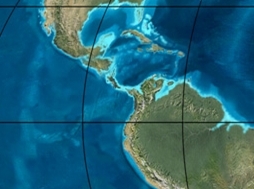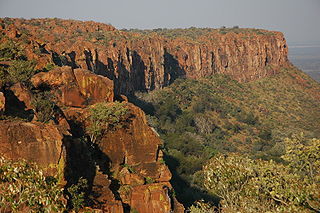
The Castillo Formation is an Early Miocene geologic formation in the Falcón Basin of Venezuela. The formation unconformably overlies the Matatere, Misoa, El Paují and Jarillal Formations. The Castillo Formation is overlain by Quaternary alluvium and in places by the Capadare Formation. The formation, deposited in a calm near-shore lagoonal brackish environment, with possibly fluvial influence, has provided a rich assemblage of fossil crocodylians, turtles, giant sloths and various types of fish.
Tetrapodium is an ichnogenus of fossil footprints found in the Etjo Sandstone and Omingonde Formations of Namibia. The Etjo Sandstone fossils were initially identified as rounded, featureless depressions presumed to have been made by a quadrupedal animal, but more recent examination in 2016 could not identify such tracks and concluded they are most likely non-biogenic features of the rock surface.

The Etjo Sandstone is an Early Jurassic geologic formation in northern Namibia. The formation overlies the Omingonde Formation in the Waterberg Basin and the Doros and Gai-As Formations in the Huab Basin and has a total thickness of 140 metres (460 ft). Fossil theropod tracks of Prosauropoda indet., Theropoda indet., Tetrapodium elmenhorsti, Saurichnium anserinum, S. damarense, S. parallelum and S. tetractis have been reported from the formation, deposited in an aeolian environment.
The Coyote Butte Limestone (OR085) is a geologic formation in Oregon. It preserves fossils dating back to the Sakmarian to Kungurian stages of the Permian period, spanning an estimated 23 million years. The formation occurs in isolated buttes to the north; Triangulation Hill, and south; type locality and name giver Coyote Butte and Tuckers Butte, on either side of the Grindstone and Twelvemile Creeks in Crook County, Oregon.

The geology of Namibia encompasses rocks of Paleoproterozoic, Mesoproterozoic and Neoproterozoic and Paleozoic to Cenozoic age. About 46% of the countryʼs surface are bedrock exposure, while the remainder is covered by the young overburden sediments of the Kalahari and Namib deserts.
The Elisabeth Bay Formation, alternatively spelled as Elizabeth Bay Formation, is an Early Miocene geologic formation in the Sperrgebiet, ǁKaras Region of southwestern Namibia, overlying the Blaubok Conglomerate. The freshwater green and red siltstones, sandstones, intercalations of conglomerates and claystones of the formation were deposited in a fluvial environment, infilling a paleovalley incised during the Oligocene low sea stand, which backfilled during the Burdigalian marine transgression. The Elisabeth Bay Formation provides many fossil mammals, snakes and other reptiles.
The Langental Formation, also spelled as Langetal Formation, is a Late Eocene geologic formation cropping out in the Sperrgebiet, ǁKaras Region of southwestern Namibia. The siltstones and sandstones of the formation were deposited in a shallow marine environment. The Langental Formation was deposited under hot and humid conditions. The formation overlies the Silica Beds unit and is overlain by the Blaubok Conglomerate. The Langental Formation provides many fossil invertebrates and fish.

The Ganigobis Formation is a Late Carboniferous (Gzhelian) to Early Permian (Artinskian) geologic formation of the Dwyka Group in the ǁKaras Region of southeastern Namibia and the Northern Cape of South Africa. The widespread formation was deposited in the Aranos and Karoo Basins of southern Africa.

The Huab Formation is an Early Permian geologic formation correlated with the Ecca Group and designated "Ecca" Group, because it does not belong to the Karoo, in the southwestern Kunene Region and northern Erongo Region of northwestern Namibia. The Huab Formation represents the oldest sedimentary unit of the Huab Basin, overlying the basement. The oil shales within the formation were deposited in a shallow lacustrine environment, and the formation marks the transition from terrestrial deposits under glacial climatic circumstances towards a warmer fluvial and marine deltaic environment.

The Whitehill Formation, alternatively written as White Hill Formation and formerly known as White Band or Whitehill or White Hill Member, is a regional Early Permian geologic formation belonging to the Ecca Group in the southeastern ǁKaras Region of southeastern Namibia and Eastern, Northern and Western Cape provinces of South Africa.

The Black Crow Limestone is an Early Eocene geologic formation in the Sperrgebiet, ǁKaras Region of southwestern Namibia. The limestones of the approximately 10 metres (33 ft) thin formation were deposited in a lacustrine to paludal environment. The formation provides many fossil mammals and amphibians, reptiles, fresh water snails and fish.

The Gai-As Formation is an Early to Middle Permian geologic formation correlated with the Ecca Group and designated "Ecca" Group, because it does not belong to the Karoo, in the southwestern Kunene Region and northern Erongo Region of northwestern Namibia. The Gai-As Formation represents the second-oldest sedimentary unit of the Huab Basin, overlying the Huab Formation. The formation was deposited in a fluvial to lacustrine setting.

The Omingonde Formation is an Early to Middle Triassic geologic formation, part of the Karoo Supergroup, in the western Otjozondjupa Region and northeastern Erongo Region of north-central Namibia. The formation has a maximum thickness of about 600 metres (2,000 ft) and comprises sandstones, shales, siltstones and conglomerates, was deposited in a fluvial environment, alternating between a meandering and braided river setting.






